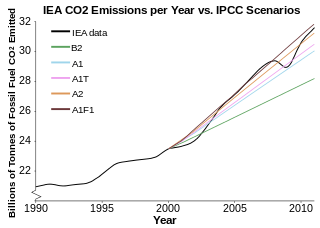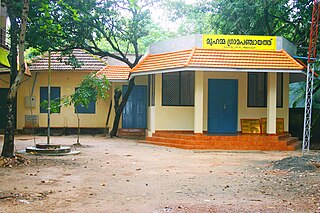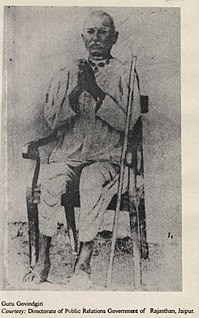
Adivasi is the collective term for tribes of the Indian Subcontinent, who are considered indigenous to places within India wherein they live, either as foragers or as tribalistic sedentary communities. The term is also used for ethnic minorities, such as Chakmas of Bangladesh, Tharus of Nepal, and Bhils of Pakistan.
The All India Democratic Women's Association (AIDWA) is the women's wing of the Communist Party of India (Marxist).

Climate change mitigation consists of actions to limit the magnitude or rate of long-term global warming and its related effects. Climate change mitigation generally involves reductions in human (anthropogenic) emissions of greenhouse gases (GHGs). Mitigation may also be achieved by increasing the capacity of carbon sinks, e.g., through reforestation. Mitigation policies can substantially reduce the risks associated with human-induced global warming.

Dungarpur District is a district of the state of Rajasthan in western India. The town of Dungarpur is the district headquarters.
Clean technology is any process, product, or service that reduces negative environmental impacts through significant energy efficiency improvements, the sustainable use of resources, or environmental protection activities. Clean technology includes a broad range of technology related to recycling, renewable energy, information technology, green transportation, electric motors, green chemistry, lighting, Greywater, and more. Environmental finance is a method by which new clean technology projects that have proven that they are "additional" or "beyond business as usual" can obtain financing through the generation of carbon credits. A project that is developed with concern for climate change mitigation is also known as a carbon project.
Panchayat samiti are rural local governments (panchayats) at the intermediate level in panchayat raj institutions (PRI).

Template:Use Indian hindi
Mahila Milan, is a self-organised collective of female pavement dwellers in Bombay. The group works with issues such as housing, sanitation and grassroots lending schemes.

Bankura Sadar subdivision is a subdivision of the Bankura district in the state of West Bengal, India.

The Global Hunger Index (GHI) is a tool that measures and tracks hunger globally, by region, and by country. The GHI is calculated annually, and its results appear in a report issued in October each year.
Local self-government in India refers to governmental jurisdictions below the level of the state. India is a federal republic with three spheres of government: central (union), state and local. The 73rd and 74th constitutional amendments give recognition and protection to local governments and in addition each state has its own local government legislation. Since 1993, local government in India takes place in two very distinct forms. Urban localities, covered in the 74th amendment to the Constitution, have Nagar Palika but derive their powers from the individual state governments, while the powers of rural localities have been formalized under the panchayati raj system, under the 73rd amendment to the Constitution. For the history of traditional local government in India and South Asia, see panchayati raj.
Climate change in Bangladesh is a pressing issue. According to National Geographic, Bangladesh is one the most vulnerable nations to the impacts of climate change. Bangladesh being located on the Tropic of Cancer receives fairly direct radiation throughout the year and maintains relatively high temperature.
National Innovations on Climate Resilient Agriculture (NICRA) was launched during February 2011 by Indian Council of Agricultural Research (ICAR) with the funding from Ministry of Agriculture, Government of India. The mega project has three major objectives of strategic research, technology demonstrations and capacity building. Assessment of the impact of climate change simultaneous with formulation of adaptive strategies is the prime approach under strategic research across all sectors of agriculture, dairying and fisheries. Evolving climate resilient agricultural technologies that would increase farm production and productivity vis-à-vis continuous management of natural and manmade resources constitute an integral part of sustaining agriculture in the era of climate change. The four modules of NICRA – natural resource management, improving soil health, crop production and livestock – is aimed making the farmers self-reliant.

The Climate and Development Knowledge Network (CDKN) works to enhance the quality of life for the poorest and most vulnerable to climate change. CDKN does this by combining research, advisory services and knowledge management in support of locally owned and managed policy processes. It works in partnership with decision-makers in the public, private and non-governmental sectors nationally, regionally and globally.
National Alliance of People's Movements is an alliance of progressive people's organizations and movements in India. It is an umbrella organisation for a larger alliance integrating various civil society organisations and individuals working towards similar goals.
In 2010, the Government of Nepal approved National Adaptation Programme of Action (NAPA). NAPA developed as a requirement under the UNFCCC to access funding for the most urgent and immediate adaptation needs from the Least Developed Countries Fund (LDCF).
Krantikari Adivasi Mahila Sangathan is a banned women's organisation based in India. The Krantikari Adivasi Mahila Sangathan (KAMS) is a successor of the Adivasi Mahila Sanghathana (AMS). The foundation of the AMS was laid by the Maoists in 1986.

K.P.Sasi is an Indian film director and Cartoonist from Bengaluru. His father K. Damodaran was a Marxist theoretician and writer and one of the founder leaders of the Communist Party in India. He started working as a cartoonist while being a student at JNU during the late seventies. He started experimenting with films on 8mm during the early eighties. His documentaries include "A Valley Refuses to Die", "We Who Make History", "Living in Fear", "In the Name of Medicine" and "Voices from a Disaster". His feature films include Ilayum Mullum, on the social and psychological violence on women in Kerala, Ek Alag Mausam and Ssh..Silence Please, a silent comedy film on development. His films have been screened and awarded at several national and international film festivals. He is one of founder member of ViBGYOR Film Festival.

Govindgiri, (1858–1931) was a social and religious reformer in the early 1900s in the adivasi-dominated border areas of present-day Rajasthan and Gujarat. He is seen as having popularized the Bhagat movement, which was first started in the 18th century.















